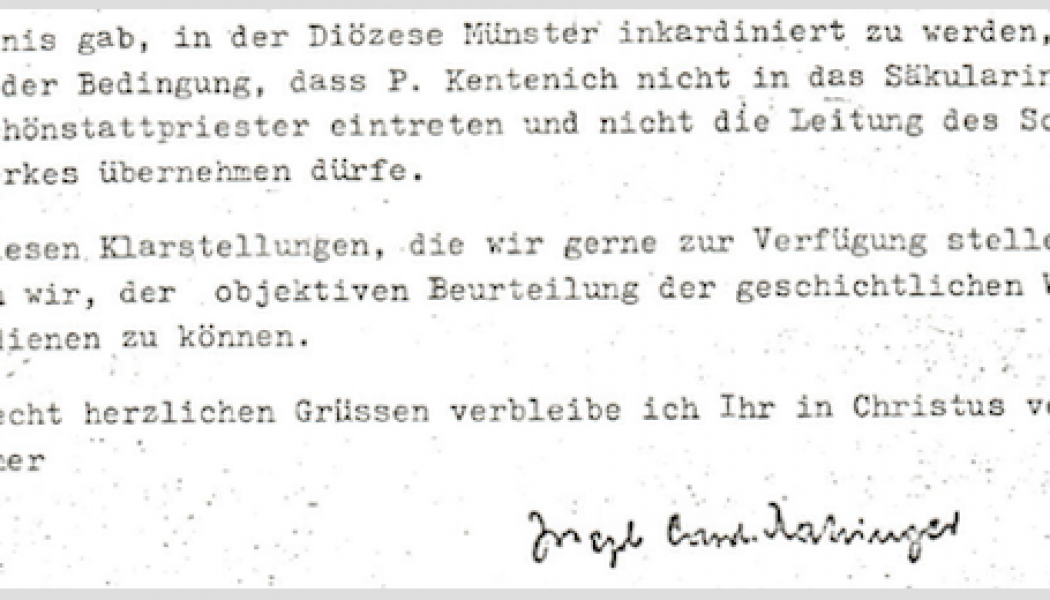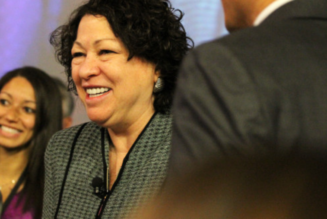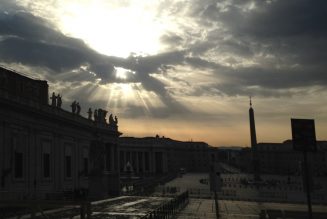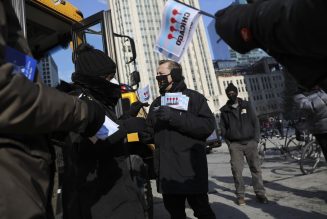
> Italiano
> English
> Español
> Français
> All the articles of Settimo Cielo in English
*
Far from rehabilitated, as claimed by his followers and supporters. In 1965 the Holy See did not by any means lift the penalties imposed in 1951 on Fr. Joseph Kentenich, the German religious who founded the international Schönstatt movement and whose beatification cause is underway.
The Holy Office only allowed him to return to Germany from exile in the United States, but continued to prohibit him from resuming contact with the Schönstatt movement, much less from taking over.
This is what is found unequivocally confirmed in the letter – translated on this page from the original German – that Cardinal Joseph Ratzinger wrote in 1982 to the superior general of the Pallottines, the religious congregation to which Kentenich originally belonged.
Now republishing this key document on Settimo Cielo is Alexandra von Teuffenbach, the Church historian who last July 2 anticipated on this same blog her research in the Vatican archives regarding the apostolic visitation of Fr. Kentenich ordered in 1951 by the Holy See , which verified his serious abuses of power and sex, and severely punished him:
> Father Master. The Founder of the Apostolic Movement of Schönstatt Abused His Nuns
Comparing Ratzinger’s resolute letter with the flimsy apologies that the superiors of Schönstatt continue to make for their founder today is Alexandra von Teuffenbach herself, in the letter that follows.
*
Dear dottore Magister,
When in the various archives I silently read those proceedings that narrate the exploitation, abuse, and humiliation inflicted by Fr. Joseph Kentenich on several nuns of his movement and decided to anticipate the scholarly study and publish these facts, I never would have imagined the reaction of the Schönstatt organization he founded.
In fact, the superiors of the movement not only deny the published facts, but they are not even distressed, on the contrary, they do not trouble themselves in the least regarding their founder and the pain he caused. They simply claim, from the very first official press release of the presidency, to be aware of everything. And that like them the diocese of Trier also knows everything. In fact, in their statement of July 1 it is maintained that “these issues have also been addressed and clarified in the beatification process started in 1975.”
Of course, a justification can be found for everything, and the news is full of such cases. But do the Schönstatt organization and the diocese of Trier really think a man can be raised to the honors of the altar and presented as an example for all Catholics who – albeit with undoubted qualities – nonetheless pushed far beyond the permissible, bringing about feelings of disgust and repugnance and causing the flight of those desperate nuns who had to subject themselves to his methods? Did he who thought of himself as a model of heavenly Father ever confront the problem? Didn’t he ever have any doubts that perhaps the bishop and the diocesan visitor, the apostolic visitor, the consultants of the Holy Office and the cardinals of that congregation and, finally, the pope could have been right? The answer is an abrupt “no.” With great arrogance he defends every one of his actions to the end, and with the same pride the members of the movement have no doubt about the work of the founder or their own, justifying the abuses with phrases that frankly belong to other eras in which the victim was blamed.
Perhaps everything can be summed up with that answer given by Fr. Angelo Strada, postulator of Kentenich’s cause until 2016, when he justifies the founder by claiming that other saints had also sinned. He says holiness does not mean being without mistakes. “St. Peter denied Jesus. St. Paul persecuted Christians. Francis of Assisi had a youth that was anything but holy […]. Only angels can be error-free. ” Evidently, comparing these saints with Fr. Kentenich, he does not see the difference: they took note of their mistakes and, with the grace of God, they changed their lives. Fr. Kentenich instead never showed – according to the biographies – the slightest sign of repentance, despite the fact that the Church, officially, repeatedly asked for it. On the contrary! But St. Peter is not a saint and an example for us because he was unaware of his betrayal until the crowing of the rooster: he is holy because he recognized his error, wept bitter tears and finally received God’s forgiveness. And it is precisely the divine mercy that we also celebrate in the life of Peter.
In the case of Kentenich – according to the leaders of Schönstatt – those who should have repented and wept bitterly were instead the first visitor – accused of having illicit relationships with the nuns who cooperated with him – and the second visitor, the Jesuit Sebastiaan Tromp, guilty of having treated with little sensitivity those nuns who had lied to the first visitor and who – as the founder wanted – had not spoken of the “family secrets.” For them and until now it was Fr. Tromp who was unable to understand the true meaning of the Schönstatt pedagogy, who was biased, unfit to distinguish the mentally ill nuns, meaning those who had something to say against Fr. Kentenich, and to understand the rambling letters from the founder. Today it is argued that Fr. Tromp – who was a Jesuit and lived in the community of the Pontifical Gregorian University – did not know community life and its internal dynamics and therefore could not understand the nuns’ relationship with Fr. Kentenich. This may make us smile, but perhaps we should also think of the suffering that continuing to sustain one’s error – by denigrating everything and everyone – inflicts on others.
The height of the founder’s defense is probably the narrative linked to his return to Europe after an exile of 14 years. If before the Second Vatican Council he – considered by Schönstatt a misunderstood precursor of that assembly – was exiled, at the end of it, when what he did was finally considered lawful (!), he was therefore rehabilitated. In fact, we read in the last interviews that Cardinal Alfredo Ottaviani, the top official of the Holy Office, by this time completely blind and retired to private life, would have apologized for the penalties he had inflicted on Kentenich. Such post-conciliar regrets are variously placed in the mouths of the most prominent characters. Perhaps it is necessary to remember that in historical science “hearsay” sources have no value and private sources also have little value when it comes to understanding the facts. There is also a hierarchy regarding sources.
The conciliar mythology strikes again. Would the Council have allowed everything, even the abuse of the nuns? Would the Council have considered it licit that a founder could act as a God-Father, free to do whatever he wants and apply every “method” to his charges, humiliating them as he pleases? The official statement from Schönstatt of July 2 2020 speaks of a 1965 rehabilitation decree, and the existence of this decree is forcefully backed by the current postulator of the cause of beatification, Fr. Eduardo Aguirre. His predecessor Strada has lately been more cautious and, contradicting the official press release and the current postulator, claims there is no rehabilitation decree because it was not in use at the time in the Holy Office. There was, however, according to him, a “de facto” rehabilitation, because Fr. Kentenich had been able to return from exile to the United States and had been able, with the approval of Rome, to resume all functions of command as before his exile, therefore as if there had never been any provision against him.
I hesitated for a long time before sending you today a 1982 letter from Cardinal Joseph Ratzinger. It is not a personal letter, but an official position, on behalf of the dicastery of which he was head, that of the congregation for the doctrine of the faith, the former Holy Office. And we read in it the refutation of many statements Schönstatt has been advancing for many decades now.
The then-prefect of the congregation for the doctrine of the faith maintains there was no mistake in the apostolic visit, there was no rehabilitation of Fr. Kentenich, and there was no permission to resume the functions of head of the organization after his return to Germany. To put it in the terms of the dispute over Vatican II: here is absolute continuity in the Church before and after the Council!
The letter in any case is not secret. It was published back in 1982 in the “Acta Societatis Apostolatus Catholici,” published in Rome, vol. X, on p. 601. I have sent you a photocopy of the original, so as not to give rise to doubts.
I hope the cardinal’s letter I send you will serve precisely the purpose for which it was written: historical truth. If the intention is then to deliberately ignore it, to insist this is only a matter of misunderstandings or – perhaps because of anti-Roman sentiment and without any regard for the victims of that time – to continue in Trier with the cause of beatification, I can only trust that historical truth as summarized in this letter by Joseph Ratzinger will be taken into account at the congregation for the causes of saints.
Alexandra von Teuffenbach
*
SACRA CONGREGATIO PRO DOCTRINA FIDEI
00193 Roma
Piazza del S. Uffizio, 11
April 2, 1982
Prot. N. 217/50
(In responsione fiat mentio huius numeri)
Most Reverend Fr. Ludwig Münz, SAC
Rector General
Piazza S. Vincenzo Pallotti, 204
00186 Roma
Most Reverend Fr. General,
After our personal meeting on March 26 of this year, in which we talked about the case of the ex-Pallottine Fr. Kentenich, as well as the relationship of this case with the previous Holy Office and with today’s Congregation for the Doctrine of the Faith, our dicastery, following our affirmations in the letter of 5-25-1981, would like to explicitly establish the following points in order to clarify any historical uncertainties:
1. The Congregation is not of the opinion that the objections the apostolic visitor made at the time to the doctrine and activity of Fr. Kentenich were an unfortunate mistake and were based on incorrect information.
2. In the session of the Holy Office of October 29 1965, none of the previous decisions of the Holy Office concerning the doctrine, activity, and person of Fr. Kentenich were rescinded; it was simply not insisted that Fr. Kentenich, having returned to Rome from the USA without the permission of the Congregation but only on the basis of a wrongly interpreted telegram, would have to go back there.
3. The Congregation gave its permission when the Congregation for Religious released Fr. Kentenich from his promises made in the Pallottine society and gave him permission to be incardinated in the diocese of Münster, but on the condition that Fr. Kentenich not enter the secular institute of the priests of Schönstatt and not take over the direction of the work of Schönstatt.
With these clarifications, which we gladly make available, we hope to serve the objective judgment of historical truth.
With cordial greetings, I remain yours in Christ
Joseph Card. Ratzinger
.








